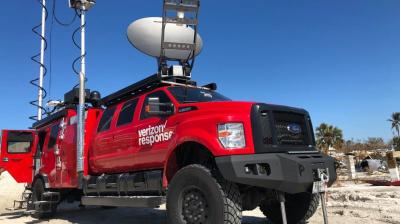Verizon is pulling out all the stops to help first responders in the wake of Hurricane Ian, and that includes THOR, the Tactical Humanitarian Operations Response vehicle that acts like a giant Swiss army knife.
THOR boasts its own private 5G network and acts as a kind of mobile command center to deliver Verizon Frontline solutions, according to Cory Davis, assistant vice president for Verizon Frontline.

Normally based outside Phoenix, Arizona, Davis has been in Florida since late last week directing Verizon’s efforts for first responders. They’re using all kinds of spectrum – millimeter wave, C-band, low band, LMR, Citizens Broadband Radio Service (CBRS) and can accommodate microwave as well, he said.
THOR is just one of the tools they’re relying on. Cells on wheels (COWs), cell on light trucks (COLTs) and portable generators are some of the others.
Obviously, interoperability is key when you’re talking about public safety and was one of the reasons behind the effort to build a nationwide network for first responders; AT&T won the contract to provide that.
But interoperability also is top of mind at Verizon, according to Davis. “We build all of our solutions and our network to be interoperable,” he said. “No matter what application or platform you’re on, we want to make sure that first responders can communicate with each other, and that’s our main mission and goal here.”
Davis has seen destruction caused by previous hurricanes over the years, but “it is total devastation down here,” he said. “This is one of the worst ones I’ve seen.”
Most of Verizon’s immediate support is going to several counties in southwestern Florida. In Fort Meyers Beach, where Davis was stationed on Wednesday, active search and rescue operations are continuing, he said
Like rivals AT&T and T-Mobile, Verizon brought its full contingent to restore cellular services in Florida, South Carolina and other areas hit by Hurricane Ian. A Category 4 storm, it tore through Florida on September 28, killing more than 100 people and causing millions of dollars in damage.
Verizon has spent billions on its network and part of that is to harden it to withstand a Category 5 hurricane, he said. “Our network is performing well and our teams are restoring it very, very quickly,” Davis said. “Things are getting better.”
Verizon has more than 100 assets in the areas, including a tethered drone on Sanibel Island that provides cellular coverage over a radius of five to seven miles to assist first responders in their search and rescue efforts.
Verizon is working with close to 70 agencies, and they all need to communicate with one another. Davis said his team helps anybody, whether they’re a Verizon customer or not.
“If there is a first responder agency that is in need of communication, we help them out,” he said.
Verizon is handing out phones, hotspots and other equipment to make sure first responders get what they need. It’s free of charge, but it’s loaned out, so the equipment eventually comes back.
Working 24/7 with search & rescue
“Obviously, it is a competitive space, but these are the times where we’re focused specifically on meeting the needs of first responders,” he said.
Those needs range from coverage and capacity to situational awareness on the ground to survey the area so that task force teams know what they’re getting into ahead of time.
They’re also in need of real-time mapping. Compared to how the area looked on September 27, “it looks nothing like that today, so it’s literally flipped upside down,” he said.
It’s still very fluid, and Davis doesn’t know how long they’ll be there. “As long as the first responders need our support, we’re going to be here to support them,” he said.